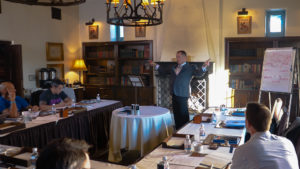There are many fantastic books to read to improve your ability to have constructive conversations; however, many of the leaders I’m working with cite “time” as their most pressing constraint. Some of what keeps many from having a thorough and complete discussion with another are their perceived lack of time. It bears repeating that none of us lacks the requisite time to do what is important; we lack focus. So, how do you make the most of your time by investing in tough conversations? First, let’s begin by relabeling them from difficult to real because we can choose how we feel. Second, make time for the entire conversation without distraction or scheduling conflict. And finally, commit to the outcome.

Tip #1: Instead of calling it tough, make it real.
Word choice matters. The avoidance instinct kicks in because so many describe conversations as difficult, tough, or confrontational. Ask yourself, when has a situation that you’ve labeled difficult, tough, or confrontational ever gotten less so over time without any action on your part or that of another? Instead, tell yourself you need to speak with a person. It’s only more complicated than that if you make it so. Reframe your self-talk with a positive outcome in mind to be authentic, real, and genuine.
For example, you need to have a difficult conversation with John about his performance, which you’ve been putting off because you don’t want to confront him about his shoddy work. Let’s reframe that sentence using the suggestion in the prior paragraph. You need to speak with John, check on his well-being, and help him succeed. The difference is subtle, yet you will feel differently about the situation by thinking about it differently. And when John enters your office, your body language, expression, and tone will all fall into place according to that reframe.

Tip #2: Make time to take time.
If the phrase, I don’t have time, paid royalties, we’d all be able to retire successfully. As you think about times you’ve used the phrase, reflect on the times you allotted too little time to resolve an issue that invariably reared its head again. How would the situation be different if every problem was solved permanently in one sitting?
You can adopt this strategy for conversations by blocking the right time for the right topic. For example, if the discussion touches on a topic that others find emotional, build time for them to process them. How long is that? You likely know your team, can anticipate their hot buttons, and build flexibility into your schedule. Not only will you find that you have the time to reach a resolution, you’ll also create trust with them.

Tip #3: Commit to the outcome.
As the saying goes, if you fail to plan, you plan to fail. The same is true in a conversation if the premise is that the parties are working toward a resolution. Once you have created the safe space with a positive intention (labeling) and reserved the time to have a complete conversation, it’s time to begin with the end in mind. That doesn’t mean a preconceived solution but rather an understanding that you will reach an agreement to take action.
Those actions will vary depending on what issues you were discussing, but the key to success will be for each to commit to the outcome. Challenge yourself for every goal/action to make them SMART (specific, measurable, attainable, relevant, and time-bound).

Turn difficult conversations into productive ones.
If you are intrigued by changing your difficult conversations into productive conversations that evoke calm rather than a storm, consider talking with Ken to discuss the impact on your team. Ken is a former Fortune 500 executive leader and current entrepreneur working with business leaders to bring simplicity, clarity, and direction to help them get more of what they want from their businesses.
You can start with a Meet & Greet to see how well we mesh, or if you’re ready to kick the tires, schedule our signature Breakthrough Strategy Session and experience a complimentary coaching experience with Ken.

As a strong leader, you want to role model good listening skills at every opportunity. If unsure where to begin, schedule a Meet & Greet, and talk with Ken Kilday.
When working with an individual leader, or their entire leadership team, Ken uses tools like Talent Dynamics to begin the journey of self-awareness necessary to be a great communicator that listens well.
A team that listens to one another has focus and intention, is efficient in the process, moves more quickly to solve problems, builds relationships, and enjoys improved profitability. Call us today to build a plan for better listening skills on your team.




